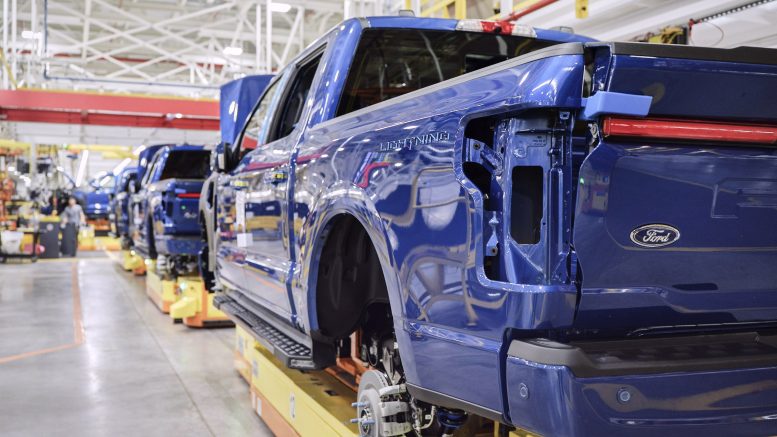Suddenly, the United States is getting serious about climate change, the green energy transition and the supply of critical minerals needed to make it happen.
The Inflation Reduction Act, passed in early August, contains US$430 billion in spending — about US$280 billion of that focused on clean energy incentives intended to fight climate change and speed up adoption of EVs and renewable energy.
This, from a country that only in 2017 – one year after becoming a signatory to the Paris Climate agreement — did an about-face and applied (under former president Donald Trump) to formally withdraw from the deal. (It has since rejoined under current president Joe Biden.)
The Inflation Reduction Act, which came as a complete surprise, squeaked through 51-50 in the Senate, with vice-president Kamala Harris casting the tiebreaker vote. On Aug. 12, it was also approved in the House of Representatives in a 220-207 vote.
While the bill alludes to reducing inflation, and contains major health policy measures, it also contained historic climate investments aimed at reducing greenhouse gas emissions by 40% below 2005 levels by 2030.
Climate investments range from tax credits for electric vehicles at US$7,500 a pop over a 10-year period, support for nuclear energy and infrastructure (almost $30 billion in tax credits over 10 years) and tax credits for investment in and production of clean energy in the form of solar panels, wind turbines, battery cells and more.
As the United States’ close neighbour and ally, one that is “affected by every twitch and grunt” of the giant (as former Prime Minister Pierre Trudeau phrased it), this puts Canada in an interesting position.
Unlike Biden’s originally proposed Build Back Better Act, and thanks to intense lobbying from the Canadian government and automakers, the Inflation Reduction Act (IRA) doesn’t shut out Canadian-assembled vehicles from eligibility for EV incentives. And the bill’s requirement that qualifying EVs contain a proportion of critical minerals and battery components that are sourced domestically, from a country with a free-trade agreement with the U.S., or recycled in North America, could provide a major boost for Canadian mining projects. That is especially the case because there is no way the U.S. will be able to secure the minerals it needs domestically. The country has only one lithium mine, one nickel mine, and no graphite mines. A number of mining projects have also seen permitting delays and legal challenges that deter investment. Add to that recently passed or proposed laws by Democrats that would de-incentivize mining (a tax on lithium production in California that will go into effect in early 2023; the proposed Clean Energy Minerals Reform Act, which would establish a 12.5% royalty on new mining operations and an 8% royalty on existing operations) or even ban mining (in Minnesota’s Boundary Waters region).
EV incentive
The EV incentive in the IRA has been criticized for being too ambitious with its sourcing targets — in particular with automakers who know how few vehicles will actually qualify for it. The bill stipulates that starting in 2023, at least 40% of the critical minerals contained in the vehicles’ batteries must be sourced or refined in the U.S. or a free trade partner country, or else recycled in North America, with that proportion rising yearly until it reaches 80%. For battery components, the proportion of “local” or “friendly” content starts at an even higher (and unrealistic) 50% in 2023, rising to 100% by 2029.
However, regardless of these “aggressive” targets, independent analyst Patricia Mohr believes these requirements will spark investments in Canada.
“While it will take time for noticeable benefits to emerge, the provisions will likely spur stepped-up investor interest in the Canadian mining, processing and auto sectors almost immediately (from foreign mining companies and private equity),” said Mohr in the August issue of the publication Critical Metals for a Sustainable World.
The federal, Quebec and Ontario governments have already made a spate of investments into mining, processing and EV battery production, but the domestic battery supply chain is still in the early stages of development.
Mohr noted that Canadian nickel projects — which are comparatively low-carbon emitters — are poised to become more valuable.
“Canada is very prospective for nickel and the United States is not. At least five early-stage nickel deposits are currently available for development in Canada; the U.S. tax credit, for which Indonesian nickel does not qualify, may be another factor spurring ultimate finance for them.”
However, given the polarized political environment in the U.S., John Kaiser, a California-based newsletter writer focused on junior miners through Kaiser Research Online, doesn’t attach much importance to the legislation.
“The bills created by Congress are meaningless because in 2024 they could be ripped up just as Trump did with the Iran nuclear deal,” he told The Northern Miner in an email.
That’s not necessarily as negative as it sounds. Kaiser, who has been calling attention to the West’s reliance on China for critical minerals for well over a decade now, says that industry is intent on the electrification pathway and companies are starting to recognize they need to do more to secure supply.
“What really struck me in early 2021 was that despite four years of Trump doing his best to undermine the energy transition, the car sector utterly ignored him and accelerated deployment and financial commitment to EVs far more than projected during the 2015-2016 cobalt-lithium boomlet,” he said.
Kaiser believes that the EV adoption trend will go exponential around 2030 — spurring a non-gold exploration and development boom in Canada.
“Eastern Canada has the capacity to become a major source of lithium by 2030. And it doesn’t matter what rules the U.S. invents about where companies must procure their metals.”





Be the first to comment on "Canada poised to benefit as the elephant next door goes green"